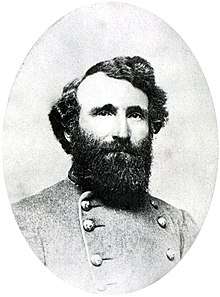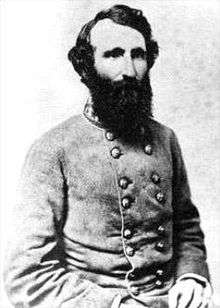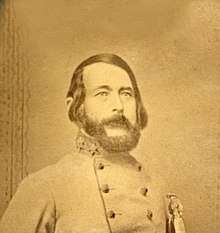William B. Taliaferro
William Booth Taliaferro ( /ˈtɒlɪvər/ TOL-i-vər; December 28, 1822 – February 27, 1898), was a United States Army officer, a lawyer, legislator, Confederate general in the American Civil War, and Grand Master of Masons in Virginia.
William B. Taliaferro | |
|---|---|
 General William B. Taliaferro | |
| Birth name | William Booth Taliaferro |
| Born | December 28, 1822 Gloucester County, Virginia |
| Died | February 27, 1898 (aged 75) Gloucester County, Virginia |
| Buried | Ware Church Cemetery, Gloucester County |
| Allegiance | |
| Service/ | |
| Years of service | 1846-48 (USA) 1861–65 (CSA) 1865 (USA) |
| Rank | |
| Unit | 9th U.S. Infantry Regiment 11th U.S. Infantry Regiment |
| Commands held | District of South Carolina District of Eastern Florida District of Savannah Jackson's Division—II Corps Taliaferro's Brigade—Jackson's Division 23rd Virginia Infantry |
| Battles/wars | Mexican–American War American Civil War |
| Relations | James A. Seddon (uncle) |
| Other work | Judge, State Politician, Egualitarian, Southern Abolitionist, States' Rights Advocate |

Early life
William Booth Taliaferro was born in Gloucester County, Virginia, to an Anglo-Italian family, the Taliaferros, who had settled in Virginia in the early 17th century from London. He was the son of Francis Amanda Todd (Booth) and Warner Throckmorton Taliaferro,[1] and the nephew of James A. Seddon, who would become Secretary of War for the Confederate States of America under Jefferson Davis.
Taliaferro attended Harvard University and The College of William and Mary, graduating from the latter in 1841.
Taliaferro joined the U.S. Army during the Mexican–American War, fighting in both the 11th and 9th U.S. Infantry regiments. After the war, Taliaferro entered public life, serving as a member of the Virginia House of Delegates and as a prominent backer of James Buchanan's presidential campaign in 1856. He also continued his military service as commander of a division of the Virginia state militia; he commanded at Harpers Ferry following the raid of that town's arsenal by John Brown.
Civil War
Taliaferro became commander of Virginia's state militia following Virginia's secession action on April 17, 1861; indeed, in what might be Virginia's 1st act of aggression of the war, on April 18, 1861, Virginia State Militia Major General Taliaferro was sent to take command at Norfolk, Virginia. Later he took command of the 23rd Virginia Infantry as a colonel. He fought several engagements in 1861 and by the end of the year had ascended to brigade command, where he led Confederate forces at the Battle of Greenbrier River, in what is now West Virginia.
Taliaferro's command, dubbed the "Second Louisiana Brigade" (after the First Louisiana Brigade commanded by Brig. Gen. Harry T. Hays), came under Maj. Gen. Thomas J. "Stonewall" Jackson's command at the end of 1861. He served with Jackson through the Valley Campaign and the Seven Days Battles. After Brig. Gen. Charles Winder was killed at Cedar Mountain, Taliaferro took over command of the Stonewall Division. He led it for the next three weeks, but at Brawner's Farm on August 28, 1862, he was badly wounded. Taliaferro spent the next few months recuperating and resumed division command just before the Battle of Fredericksburg in December, where he did not see any significant action.
Taliaferro was a strict and aloof commander who alienated many of his troops. There is at least one known circumstance when one of his troops actually assaulted him, though Taliaferro was unscathed. Taliaferro chafed under the command of General Jackson, complaining to his political colleagues in Virginia about Jackson's tactics and treatment of the men. Jackson later protested Taliaferro's promotion to brigadier general, while Taliaferro was still under Jackson's command; however, Jackson respected Taliaferro's leadership and military ability and did not continue to stand in his way. Jackson later would select Taliaferro for temporary divisional command in specific engagements.
After Fredericksburg, Taliaferro was given command of the District of Savannah. In this capacity he led troops at the Battle of Fort Wagner on Morris Island, a battle which is depicted in the movie Glory. Taliaferro was commended for his service in that battle.
In 1864, Taliaferro was given command of all forces in the Eastern District of Florida, which made him the overall commander at the Battle of Olustee that February. He subsequently returned to South Carolina, where he was made commander of all forces in that state. Taliaferro was still in command when Maj. Gen. William T. Sherman entered the state from Savannah.
In early 1865, Taliaferro's men came across an abandoned plantation in western Virginia while retreating from Antebellum, Maryland. The African workers had been shackled and abandoned. Taliaferro ordered his men to release the enslaved and escort them to the Ohio border.Needs citation
Postbellum career
After the war, Taliaferro lived in Gloucester County. He served again in the state legislature and as a judge and sat on the board of the College of William and Mary and the Virginia Military Institute. He was elected Grand Master of Masons in Virginia in 1874. He died at his home, "Dunham Massie", aged 75, and is buried in Ware Church Cemetery, Gloucester County, Virginia. His collected papers are located at the Special Collections Research Center at the College of William and Mary.[2] Taliaferro is also the namesake of a residence hall at William and Mary.[3]
Family tree

Bartholomew Taliaferro (1530 Venice, Italy – September 1601, London, England) married Joane Lane, January 1, 1583, at St. Michael's, Cornhill, London, England. The couple is the common ancestors of cousins Brig. Gen. William Booth Taliaferro and Maj. Gen Dabney Herndon Maury (May 21, 1822 – January 11, 1900).
Both generals are descendants of Francis Taliaferro, b. c.1589, London, England.
Alexander Galt Taliaferro, Culpeper, Virginia, a brother of Gen. William B. Taliaferro, was the colonel of the 13th and then 23rd Virginia Infantry.[4]
Notes
- Gloucester County, by Sara E. Lewis
- "William Booth Taliaferro Papers". Special Collections Research Center, Earl Gregg Swem Library, College of William and Mary. Retrieved 22 January 2011.
- "William & Mary - Taliaferro Hall". Wm.edu. Retrieved 2016-07-02.
- CONFEDERATE COLONEL ALEXANDER G TALIAFERRO CIVIL WAR VETERAN CROSS OF HONOR
References
- Eicher, John H., and David J. Eicher, Civil War High Commands. Stanford: Stanford University Press, 2001. ISBN 978-0-8047-3641-1.
- Sifakis, Stewart. Who Was Who in the Civil War. New York: Facts On File, 1988. ISBN 978-0-8160-1055-4.
- Warner, Ezra J. Generals in Gray: Lives of the Confederate Commanders. Baton Rouge: Louisiana State University Press, 1959. ISBN 978-0-8071-0823-9.
External links
| Wikisource has original works written by or about: William B. Taliaferro |
- "William B. Taliaferro". Find a Grave. Retrieved 2008-02-13.
- William Booth Taliaferro Papers